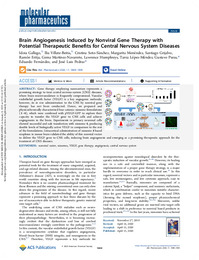Title:
Brain Angiogenesis Induced by Nonviral Gene Therapy with Potential Therapeutic Benefits for Central Nervous System Diseases |
Authors:
Gallego, Idioa
Villate Beitia, Ilia 
Soto-Sánchez, Cristina 
Menéndez, Margarita
Grijalvo, Santiago
eritja, ramon 
Martínez Navarrete, Gema
Humphreys, Lawrence
López Méndez, Tania
Puras, Gustavo 
Fernández, Eduardo
Pedraz, José Luis |
Editor:
ACS Publications |
Department:
Departamentos de la UMH::Histología y Anatomía |
Issue Date:
2020-06-01 |
URI:
https://hdl.handle.net/11000/34581 |
Abstract:
Gene therapy employing nanocarriers represents a promising strategy to treat central nervous system (CNS) diseases, where brain microvasculature is frequently compromised. Vascular endothelial growth factor (VEGF) is a key angiogenic molecule; however, its in vivo administration to the CNS by nonviral gene therapy has not been conducted. Hence, we prepared and physicochemically characterized four cationic niosome formulations
(1−4), which were combined with pVEGF-GFP to explore their
capacity to transfer the VEGF gene to CNS cells and achieve angiogenesis in the brain. Experiments in primary neuronal cells showed successful and safe transfection with niosome 4, producing double levels of biologically active VEGF in comparison to the rest of the formulations. Intracortical administration of niosome 4 based
nioplexes in mouse brain validated the ability of this nonviral vector to deliver the VEGF gene to CNS cells, inducing brain angiogenesis and emerging as a promising therapeutic approach for the treatment of CNS diseases.
|
Keywords/Subjects:
nonviral vector
niosomes
VEGF
gene therapy
angiogenesis
central nervous system |
Type of document:
info:eu-repo/semantics/article |
Access rights:
info:eu-repo/semantics/openAccess
Attribution-NonCommercial-NoDerivatives 4.0 Internacional |
DOI:
doi: 10.1021/acs.molpharmaceut.9b01213 |
Published in:
Mol Pharm . 2020 Jun 1;17(6):1848-1858 |
Appears in Collections:
Artículos Histología y anatomía
|

.png)
